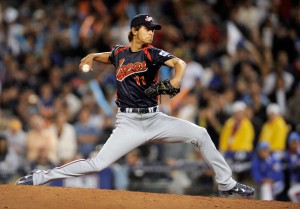
Kevin Gausman made his MLB debut on 5/23/13 just a year after pitching in the SEC. Photo unk via orioles-nation.com
With no Nats game on Thursday 5/23/13, and with a vested interest in newly promoted Orioles starter Kevin Gausman (my vested interest being that I was considering nabbing him in my fantasy league), I watched his first start against Toronto.
First thoughts; Wow. I know Gausman’s line wasn’t that great last night, but I just pulled up his Pitch F/X data on the night and am impressed. He threw 63 fastballs on the night with an AVERAGE speed of 97.26. By way of comparison, right now Stephen Strasburg leads the majors in average fastball velocity at 95.4. This kid was holding that average velocity through 60+ fastballs and 90 pitches on the night. That’s some serious heat. His mechanics were clean, the arm action easy, and he easily kept his mechanics while pitching from the stretch. Gausman has good size (6’3″ 190) and has raced through the minors to make this debut in 2013, only the 3rd guy out of last year’s draft to do so (Mike Roth, Paco Rodriguez).
He has a fantastic change-up with reverse action away from left-handed hitters (this was what his scouting report said too): 84mph average. That’s a 13mph delta between his 4 seamer and his change up. That’s just silly. In a recent post I posted a table of average velocities for the pitches of some of the league’s top pitchers; the best fb-ch delta out of that group of hard-throwers was Samardzija‘s 11.6 mph delta. Strasburg’s is only 7.4mph difference and he’s considered to have a completely unhittable change up. Gausman’s change is almost too slow; hitters sitting on 98mph may actually have enough time to re-adjust to his change. Though that being said, he got a lot of strikes and some silly swings on the change on the night.
He didn’t really use his curve that much; 11 times out of his 89 pitches (pitch f/x gives him both a slider and a curve, but the speeds look the same and the speed delta has to be a curve; his slider would be nearer 91mph). At one point he threw 4 straight changeups, which directly led to a walk b/c the hitter (Colby Rasumus) knew what was coming and laid off. I bet this kid has never thrown four straight changeups in his entire life. Wasn’t a fan of that At-bat nor the pitch calling from Weiters. He may need to develop a 4th pitch, or at least work on his curve, despite how plus his firs two offerings may be.
The hits he gave up were a combination of legitimate and lucky. Later on Rasmus laced a 2-0 fastball that he could sit on (he’s a dead-red fastball hitter who got a fastball in a fastball count, another poor job of calling that at-bat again from Weiters). Lind wristed an 0-2 pitch for a hit on a hanging curve. He gave up at least two other 2-strike hits when he missed his spot. Lawrie bunted and Chris Davis misplayed the play, calling off the pitcher only to let the ball try to go foul and it didn’t. That led to a bases-loaded no outs situation in the 4th and he was lucky to get out of that with only one run. Even the 5th inning homer he gave up seemed weak; Arencibia didn’t seem like he got it all; it was an inside pitch that he wristed out. He hit the ball 369 feet as it turns out; Toronto is an easy place to hit down-the-line homers like this. Hittracker classified the homer as being “plenty long” and it would have been out of 22/30 parks in the league, so maybe it wasn’t as lucky as I’m characterizing it.
I was slightly surprised to see Gausman get yanked after 5innings. He was through the meat of Toronto’s order and was facing 8-9-1 in the 6th on only 89 pitches. Looking at the score, yes you’d understand him getting pulled. Looking at his stuff and what had transpired? I’d have given him another inning with a short leash (one baserunner and you’re out). Showalter had seen enough though, brought in a couple of relievers who promptly conspired to give up a grand slam to Encarnacion and blow the game. Loss for Gausman in his MLB debut.
Final line: 5ip, 7hits, 2 walks, 5 Ks and 4 earned runs. 89 pitches 58 strikes for a 65% clip. He had a 49/5 K/BB ratio in the minors this year, an amazingly good ratio for someone with 99mph heat, so the two walks were uncharacteristic. Very much looking forward to his next outing.
